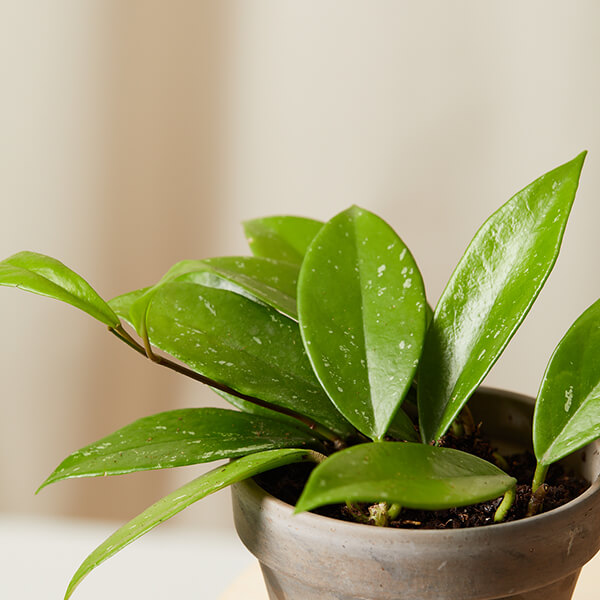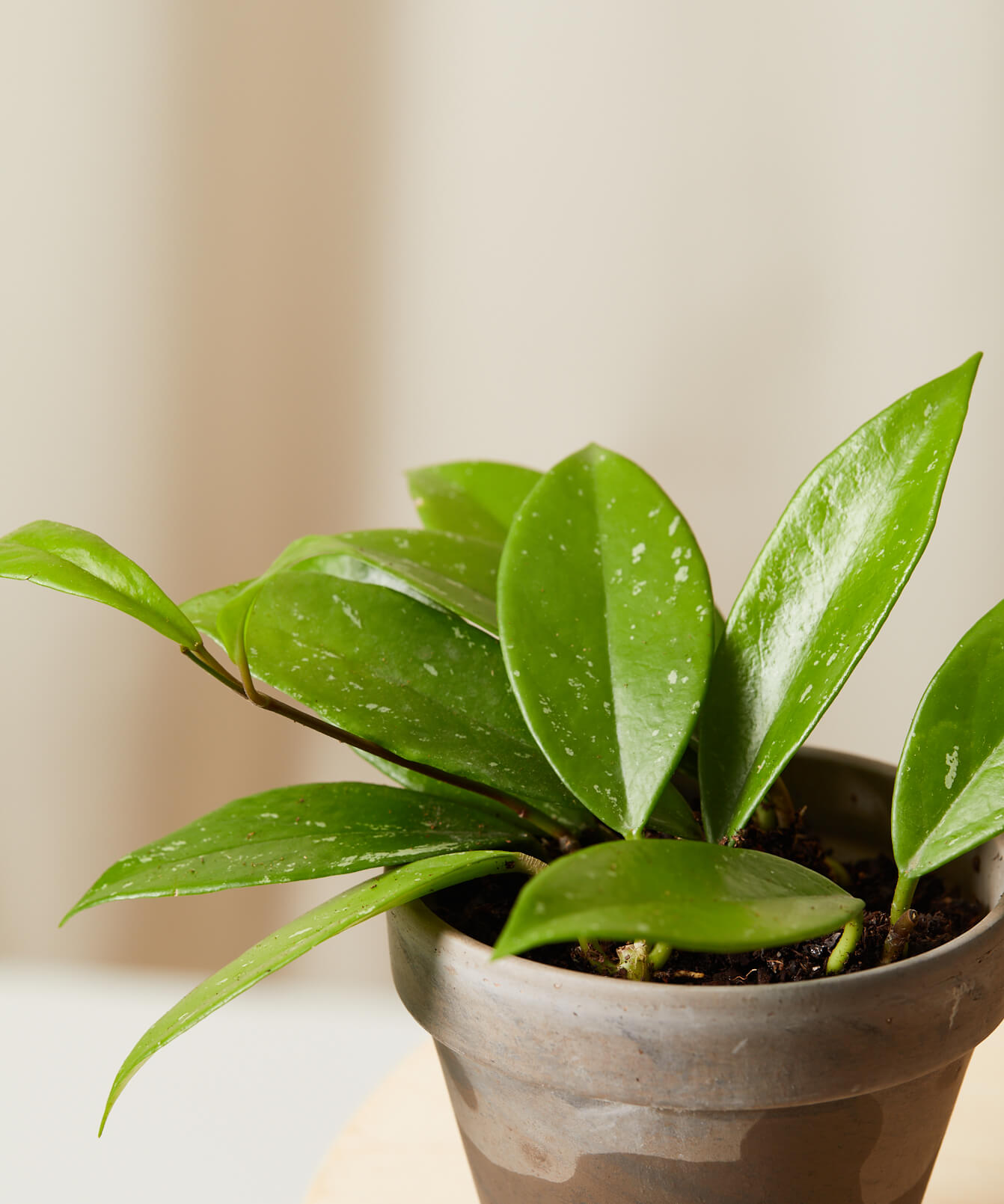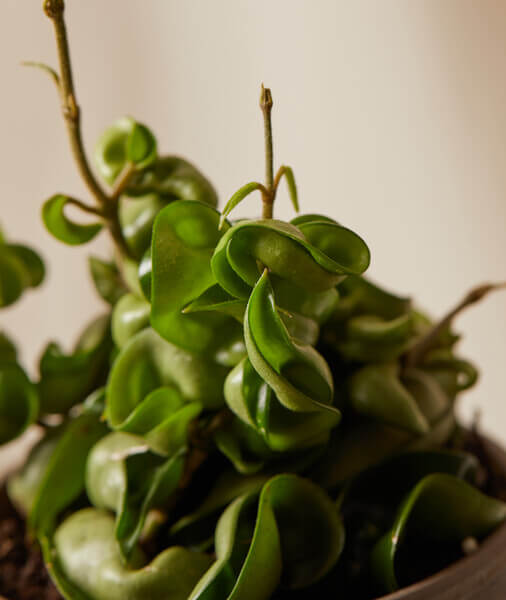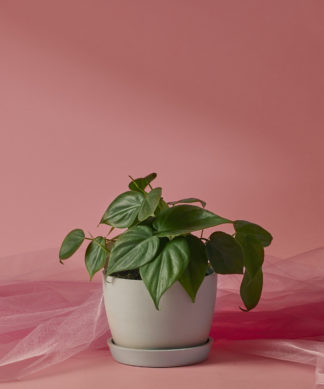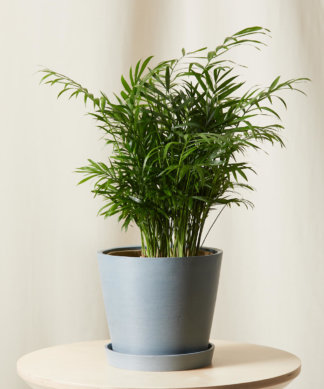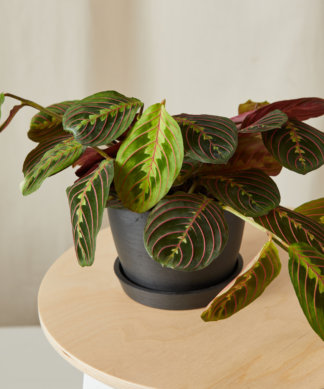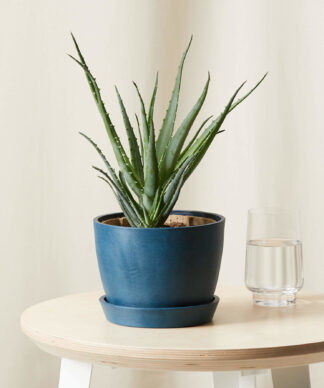How to care for your Hoya
Use these instructions to care for a Hoya. This guide will tell you how to water a Hoya; its light, temperature, humidity preferences and any additional care it might need to help it grow.
Green Hoya
Your Hoya will thrive in medium to bright indirect light. It can tolerate lower light but will likely produce flowers if placed in brighter light. The more light it receives, the more vibrant the foliage and the more flowers it will produce.
Water your Hoya when the pot becomes completely dry. Water thoroughly until water flows from the drainage hole on the bottom of the pot. Discard any excess water in the saucer. If your Hoya begins to drop its leaves, most likely it is being watered too much. Hoyas require less water in the winter months.
Your Hoya Plant will do just fine in average household humidity.
The ideal room temperature for your Hoya is between 60-85 degrees. If the temperature falls below 55 degrees, it will stop growing. Avoid drafts and direct air from heating and cooling vents.
For best results, use a general-purpose liquid houseplant fertilizer at half strength once every month during the spring and summer. There is no need to feed your plant in the winter when growth naturally slows. Before applying any form of fertilizer make sure the soil is damp. Never apply fertilizer to dry soil.
Hoya Plants are non-poisonous to humans and pets.
When Hoya plants mature, they will produce clusters of star-shaped flowers from their tendrils. Do not remove the spent flower stems or tendrils after your Hoya blooms–it will produce flowers on those stems again the next time it blooms. Also, do not move the Hoya after it begins to develop new flower buds. Moving the Hoya could disturb it and cause it to drop the buds before they open.
Hoya Compacta
Your Hoya will thrive in medium to bright indirect light. It can tolerate lower light but will likely produce flowers if placed in brighter light. The more light it receives, the more vibrant the foliage and the more flowers it will produce.
Water your Hoya when the pot becomes completely dry. Water thoroughly until water flows from the drainage hole on the bottom of the pot. Discard any excess water in the saucer. If your Hoya begins to drop its leaves, most likely it is being watered too much. Hoyas require less water in the winter months.
Your Hoya Plant will do just fine in average household humidity.
The ideal room temperature for your Hoya is between 60-85 degrees. If the temperature falls below 55 degrees, it will stop growing. Avoid drafts and direct air from heating and cooling vents.
For best results, use a general-purpose liquid houseplant fertilizer at half strength once every month during the spring and summer. There is no need to feed your plant during winter when growth naturally slows. Before applying any form of fertilizer make sure the soil is damp. Never apply fertilizer to dry soil.
Hoya Plants are non-toxic to humans and pets.
When Hoya plants mature, they will produce clusters of star-shaped flowers from their tendrils. Do not remove the spent flower stems or tendrils after your Hoya blooms–it will produce flowers on those stems again the next time it blooms. Also, do not move the Hoya after it begins to develop new flower buds. Moving the Hoya could disturb it and cause it to drop the buds before they open.
Hoya Curtisii
Your Hoya will thrive in medium to bright indirect light. It can tolerate lower light but will likely produce flowers if placed in brighter light. The more light it receives, the more vibrant the foliage and the more flowers it will produce.
Water your Hoya when the pot becomes 100% dry. Water thoroughly until water flows through the drainage hole. Discard any excess water in the saucer.
Your Hoya Plant will do fine in average household humidity but will appreciate added humidity.
The ideal room temperature for your Hoya is between 60-85 degrees. If the temperature falls below 55 degrees, it will stop growing. Avoid drafts and direct air from heating and cooling vents.
For best results, use a general-purpose liquid houseplant fertilizer at half strength once every month during the spring and summer. There is no need to feed your plant in the winter when growth naturally slows. Before applying any form of fertilizer make sure the soil is damp. Never apply fertilizer to dry soil.
Hoya Plants are non-toxic to humans and pets.
When Hoya plants mature, they will produce clusters of star-shaped flowers. Do not remove the spent flower stems after your Hoya blooms–it can produce flowers on those stems again the next time it blooms. Also, do not move the Hoya after it begins to develop new flower buds. Moving the Hoya could disturb it and cause it to drop the buds before they open.
Hoya Heart - Trailing
Your Hoya Heart will grow more quickly in indirect light and can maintain growth in lower lighting. Careful not to expose it to prolonged direct sun as it can scorch the leaves.
Water the Hoya Heart when the soil is 100% dry. Water thoroughly until you see it flow out of the drainage hole. Discard any excess water in the tray to discourage root rot.
The Hoya Heart does fine in normal household humidity, but will appreciate the occasional humidity boost.
Hoyas do well in temperatures between 60-85°F.
For best results, use a general-purpose liquid houseplant fertilizer at half strength once every month during the spring and summer. There is no need to feed your plant in the winter when growth naturally slows. Before applying any form of fertilizer make sure the soil is damp. Never apply fertilizer to dry soil.
Hoyas are nontoxic to humans and pets.
Your Hoya will put out long tendrils that grow new leaves and flowers so you can leave them be. They like to attach to trees and other structures in the wild. You can train these on a stake, trellis, or sometimes it will attach to something nearby.
Hoya Heart - Single Leaf
Your Hoya Heart prefers bright indirect light but can maintain in lower lighting. Be careful not to expose it to prolonged direct sun as it can scorch the leaves.
Water your Hoya Heart when the soil is 100% dry. Water thoroughly until you see it flow out of the drainage hole. Discard any excess water in the tray to discourage root rot.
The Hoya Heart does fine in average household humidity but will appreciate the occasional humidity boost.
Hoyas do well in temperatures between 60-85°F.
Feed once per month in the spring and summer with an all-purpose fertilizer for indoor plants, diluted to half strength. Never apply fertilizer to dry soil.
Hoyas are considered non-toxic to humans and pets.
Keep your Hoya looking its best by dusting its adorable heart-shaped leaf.
Hoya Kentiana
Place your hoya in low to indirect light. The more light the plant receives, the faster it will grow and encourage the plant to bloom.
Water when soil volume is 100% dry. Water thoroughly until you see it flow out of the drainage hole. Discard any excess water to discourage root rot.
Your plant does fine in average household humidity, but won’t mind added humidity.
Hoyas do well in temperatures between 60-85°F.
For best results, use a general-purpose liquid houseplant fertilizer at half strength once every month during the spring and summer. There is no need to feed your plant in the winter when growth naturally slows. Before applying any form of fertilizer make sure the soil is damp. Never apply fertilizer to dry soil.
Hoya Kentiana are non-toxic to humans and pets.
When Hoya plants mature, they will produce clusters of star-shaped flowers from their tendrils. Do not remove the spent flower stems or tendrils after your Hoya blooms–it will produce flowers on those stems again the next time it blooms. Also, do not move the Hoya after it begins to develop new flower buds. Moving the Hoya could disturb it and cause it to drop the buds before they open.
Hoya Krimson Princess
Place your hoya in low to indirect light. The more light the plant receives, the faster it will grow and encourage the plant to bloom.
Water when the soil volume is 100% dry. Water thoroughly until you see it flow out of the drainage hole. Discard any excess water to discourage root rot.
Your plant does fine in average household humidity, but won’t mind added humidity.
Hoyas do well in temperatures between 60-85°F.
For best results, use a general-purpose liquid houseplant fertilizer at half strength once every month during the spring and summer. There is no need to feed your plant in the winter when growth naturally slows. Before applying any form of fertilizer make sure the soil is damp. Never apply fertilizer to dry soil.
Hoyas are non toxic to humans and pets
When Hoya plants mature, they will produce clusters of star-shaped flowers from their tendrils. Do not remove the spent flower stems or tendrils after your Hoya blooms–it will produce flowers on those stems again the next time it blooms. Also, do not move the Hoya after it begins to develop new flower buds. Moving the Hoya could disturb it and cause it to drop the buds before they open.
Hoya Krimson Queen
Your Hoya will thrive in medium to bright indirect light. It can tolerate lower light but will likely produce flowers if placed in brighter light. The more light it receives, the more vibrant the foliage and the more flowers it will produce.
Water when soil volume is 100% dry. Water thoroughly until you see it flow out of the drainage hole. Discard any excess water to discourage root rot.
Your plant does fine in average household humidity, but won’t mind added humidity.
Hoyas do well in temperatures between 60-85°F.
For best results, use a general-purpose liquid houseplant fertilizer at half strength once every month during the spring and summer. There is no need to feed your plant in the winter when growth naturally slows. Before applying any form of fertilizer make sure the soil is damp. Never apply fertilizer to dry soil.
Hoya Plants are non-toxic to humans and pets.
When Hoya plants mature, they will produce clusters of star-shaped flowers. Do not remove the spent flower stems after your Hoya blooms–it can produce flowers on those stems again the next time it blooms. Also, do not move the Hoya after it begins to develop new flower buds. Moving the Hoya could disturb it and cause it to drop the buds before they open.
Hoya Krohniana
Place your Hoya Krohniana in indirect bright light. It can maintain in lower lighting, but growth will be slow and it most likely will not flower. Too much light can burn the leaves.
Water your Hoya when the soil is 100% dry. Water thoroughly and discard any excess water to avoid root rot.
The Hoya Krohniana does well in average household humidity but appreciates the occasional misting.
The ideal room temperature for your Hoya is between 60-85°F. If the temperature falls below 55°F, it will stop growing. Avoid drafts and direct air from heating and cooling vents.
For best results, use a general-purpose liquid houseplant fertilizer at half strength once every month during the spring and summer. There is no need to feed your plant in the winter when growth naturally slows. Before applying any form of fertilizer make sure the soil is damp. Never apply fertilizer to dry soil.
Hoyas are non-toxic to humans and pets
When Hoya plants mature, they will produce clusters of star-shaped flowers from their tendrils. Do not remove the spent flower stems or tendrils after your Hoya blooms–it will produce flowers on those stems again the next time it blooms. Also, do not move the Hoya after it begins to develop new flower buds. Moving the Hoya could disturb it and cause it to drop the buds before they open.
Hoya Lisa
Your Hoya will thrive in medium to bright indirect light. It can tolerate lower light but will likely produce flowers if placed in brighter light. The more light it receives, the more vibrant the foliage and the more flowers it will produce.
Water when soil volume is 100% dry. Water thoroughly until you see it flow out of the drainage hole. Discard any excess water to discourage root rot.
Your plant does fine in average household humidity, but won’t mind added humidity.
Hoyas do well in temperatures between 60-85°F.
For best results, use a general-purpose liquid houseplant fertilizer at half strength once every month during the spring and summer. There is no need to feed your plant in the winter when growth naturally slows. Before applying any form of fertilizer make sure the soil is damp. Never apply fertilizer to dry soil.
Hoya Plants are non-toxic to humans and pets.
When Hoya plants mature, they will produce clusters of star-shaped flowers. Do not remove the spent flower stems after your Hoya blooms–it can produce flowers on those stems again the next time it blooms. Also, do not move the Hoya after it begins to develop new flower buds. Moving the Hoya could disturb it and cause it to drop the buds before they open.
Hoya Macrophylla
Place your hoya in low to indirect light. The more light the plant receives, the faster it will grow and encourage the plant to bloom.
Water when soil volume is 100% dry. Water thoroughly until you see it flow out of the drainage hole. Discard any excess water to discourage root rot.
Your plant does fine in average household humidity, but won’t mind added humidity.
Hoyas do well in temperatures between 60-85°F.
For best results, use a general-purpose liquid houseplant fertilizer at half strength once every month during the spring and summer. There is no need to feed your plant in the winter when growth naturally slows. Before applying any form of fertilizer make sure the soil is damp. Never apply fertilizer to dry soil.
Hoya Plants are non-toxic to humans and pets.
When Hoya plants mature, they will produce clusters of star-shaped flowers from their tendrils. Do not remove the spent flower stems or tendrils after your Hoya blooms–it will produce flowers on those stems again the next time it blooms. Also, do not move the Hoya after it begins to develop new flower buds. Moving the Hoya could disturb it and cause it to drop the buds before they open.
Hoya Pachyclada
Your Hoya will thrive in medium to bright indirect light. It can tolerate lower light but will likely produce flowers if placed in brighter light. The more light it receives, the more vibrant the foliage and the more flowers it will produce.
Water your Hoya when the pot becomes completely dry and even let the leaves wrinkle up a bit. Water thoroughly until water flows from the drainage hole on the bottom of the pot. Discard any excess water in the saucer. If your Hoya begins to drop its leaves, most likely it is being watered too much. Hoyas require less water in the winter months.
Your Hoya Plant will do just fine in average household humidity.
The ideal temperature for your Hoya is between 60-85 degrees.
Use a general-purpose liquid houseplant fertilizer at half strength once every month during the spring and summer. There is no need to feed your plant in the winter when growth naturally slows. Before applying any form of fertilizer make sure the soil is damp. Never apply fertilizer to dry soil, this can cause fertilizer burn.
Hoya Pachyclada are non-toxic to humans and pets.
When Hoya plants mature, they will produce clusters of star-shaped flowers. Do not remove the spent flower stems after your Hoya blooms–it will produce flowers on those stems again the next time it blooms. Also, do not move the Hoya after it begins to develop new flower buds. Moving the Hoya could disturb it and cause it to drop the buds before they open.
Hoya Retusa
Your Hoya will thrive in medium to bright indirect light. It can tolerate lower light but will likely produce flowers if placed in brighter light. The more light it receives, the more vibrant the foliage and the more flowers it will produce.
Water your Hoya when the pot becomes 100% dry. Water thoroughly until water flows through the drainage hole. Discard any excess water in the saucer.
Your Hoya Plant will do fine in average household humidity but will appreciate added humidity.
The ideal room temperature for your Hoya is between 60-85 degrees. If the temperature falls below 55 degrees, it will stop growing. Avoid drafts and direct air from heating and cooling vents.
For best results, use a general-purpose liquid houseplant fertilizer at half strength once every month during the spring and summer. There is no need to feed your plant in the winter when growth naturally slows. Before applying any form of fertilizer make sure the soil is damp. Never apply fertilizer to dry soil.
Hoya Plants are non-toxic to humans and pets.
When Hoya plants mature, they will produce clusters of star-shaped flowers. Do not remove the spent flower stems after your Hoya blooms–it can produce flowers on those stems again the next time it blooms. Also, do not move the Hoya after it begins to develop new flower buds. Moving the Hoya could disturb it and cause it to drop the buds before they open.
Speckled Hoya
Your Hoya will thrive in medium to bright indirect light. It can tolerate lower light but will likely produce flowers if placed in brighter light. The more light it receives, the more vibrant the foliage and the more flowers it will produce.
Water your Hoya when the pot becomes completely dry. Water thoroughly until water flows from the drainage hole on the bottom of the pot. Discard any excess water in the saucer. If your Hoya begins to drop its leaves, most likely it is being watered too much. Hoyas require less water in the winter months.
Your Hoya Plant will do just fine in average household humidity.
The ideal room temperature for your Hoya is between 60-85 degrees. If the temperature falls below 55 degrees, it will stop growing. Avoid drafts and direct air from heating and cooling vents.
For best results, use a general-purpose liquid houseplant fertilizer at half strength once every month during the spring and summer. There is no need to feed your plant in the winter, when growth naturally slows. Before applying any form of fertilizer make sure the soil is damp. Never apply fertilizer to dry soil.
Hoya Plants are non-poisonous to humans and pets.
When Hoya plants mature, they will produce clusters of star-shaped flowers from their tendrils. Do not remove the spent flower stems or tendrils after your Hoya blooms–it will produce flowers on those stems again the next time it blooms. Also, do not move the Hoya after it begins to develop new flower buds. Moving the Hoya could disturb it and cause it to drop the buds before they open.






